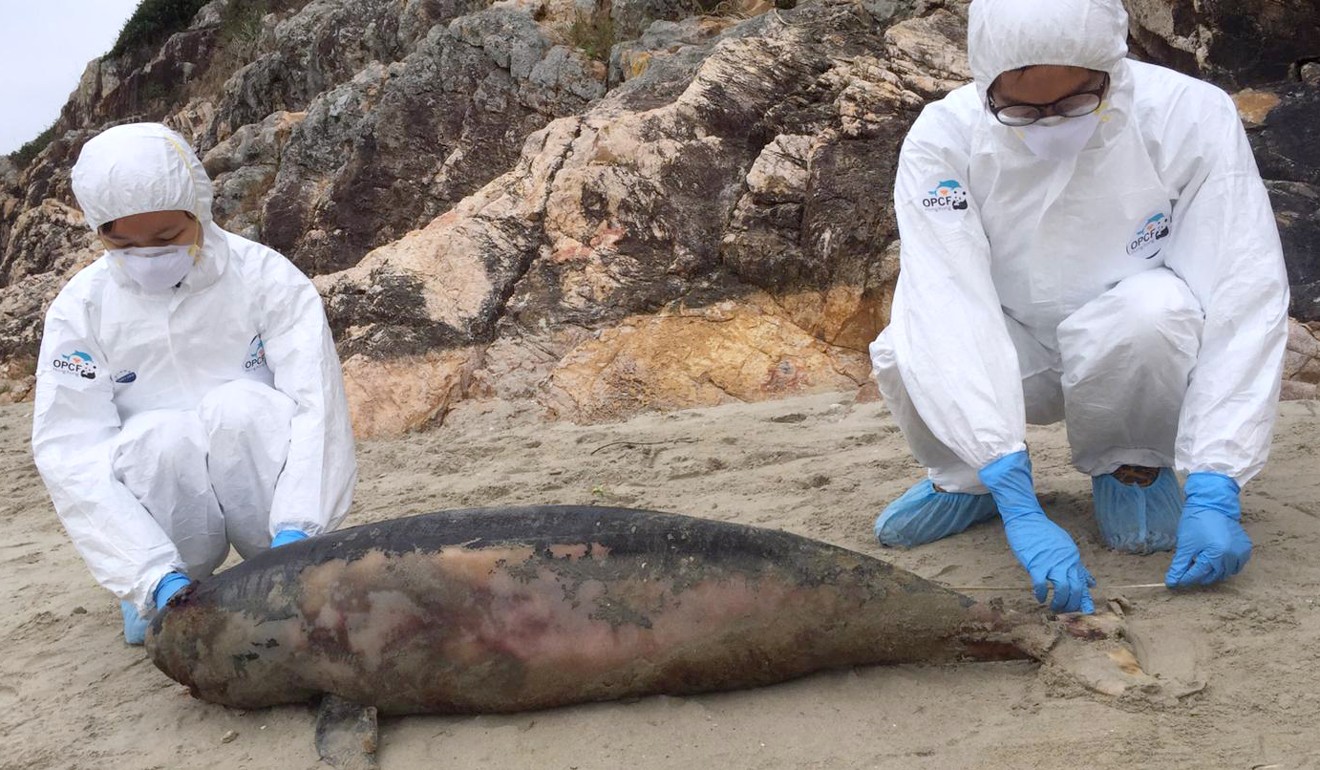
Two porpoise carcasses found on separate Hong Kong shores, bringing number of cases this year to 15 – an alarming trend, green groups warn
- Cause of deaths remains unclear, while inconclusive population data makes it hard for experts to analyse statistics
- Most cases record blunt force trauma to marine mammal, indicating collisions with vessels, but lack of other related injuries lends little weight to theory
Two porpoise carcasses were found on separate Hong Kong shores on Sunday, bringing the total number of stranded cases involving the marine animal to 15 this year – a figure that was alarming, conservationists warned.
The severely decomposed bodies of an adult male and male calf, measuring 1.66 metres and 1.36 metres respectively, were found in Tap Mun and Sai Kung, with the latter having a 34cm wound on its abdomen. Both belong to the finless porpoise species.
The incidents were reported to the Ocean Park Conservation Foundation, which helps the government respond to and investigate all stranded cetacean cases.

“The causes of death are yet to be determined,” a foundation spokesman said. “[The foundation] has transported the carcasses to Ocean Park for further necropsy.”
The 13 cases in January marked the highest tally for a single month since the group began handling such cases in 2006.
Remains of two finless porpoise discovered, taking total number found since start of year to eight
It remains unclear what caused the animals’ deaths and where they occurred at sea – bodies could be carried to different shores by currents – or if the frequency of the cases is considered natural.
An uptick in reports could be attributed to increased public awareness and willingness to report sightings, according to the park.
Gary Stokes, founder and CEO of conservation group OceansAsia, said the lack of updated and scientific baseline population data meant no one could gauge the implications of the numbers.
“Fundamentally, we need to first understand the population [of the animal] in Hong Kong, because right now we have no idea,” he said. “We can’t quantify whether 13 in a month is a catastrophe or acceptable.”
However, Stokes said he believed the record-high cases last month were “not just a statistical anomaly”, adding there was something abnormal going on.
Fundamentally, we need to first understand the population [of the animal] in Hong Kong, because right now we have no idea
He observed that many porpoises had suffered blunt force trauma – usually indicating a collision with a boat – and fractured vertebrae. But the lack of cuts from hull barnacles and propeller blades in those same corpses made Stokes sceptical about such explanations.
“Whether they are being deafened by more underwater noise, and becoming less alert and susceptible to collisions, or tangled in nets as by-catch and just dumped back into the sea; it’s anyone’s guess,” he said. “We need more evidence.”
Taison Chang Ka-tai, chairman of the Hong Kong Dolphin Conservation Society, said the numbers were “not normal”. “There is no one reason for the deaths but I believe they are mostly human-induced,” he said.
Because most carcasses were found severely decomposed, Ocean Park was only able to determine the cause of death in 10 per cent of the cases since 2006. The top identifiable causes are entanglement in abandoned fishing nets or equipment, collisions with boats, and infection.
But Chang added: “Whatever it is, the environment for the finless porpoise and Chinese white dolphin is getting worse all over Hong Kong.”
Ambitious move to save world’s smallest porpoise, led by Hong Kong Ocean Park animal expert
Fewer fish stocks meant more porpoises were foraging near fishing nets, while more nearshore construction projects and work boats traversing around their habitats could be increasing disturbance, Chang said.
Last year, 33 cases in total were reported, the highest in a year since 2014.
The finless porpoise, a sea mammal, is found in coastal waters in Asia, and is listed as a threatened species internationally.
While there are no estimates on exact numbers in local waters, the Agriculture, Fisheries and Conservation Department previously calculated a minimum population size of 217.
But on its website, the department stated: “This could be probably an underestimate because finless porpoises are very difficult to spot on surveys and some areas have not been extensively studied.”

